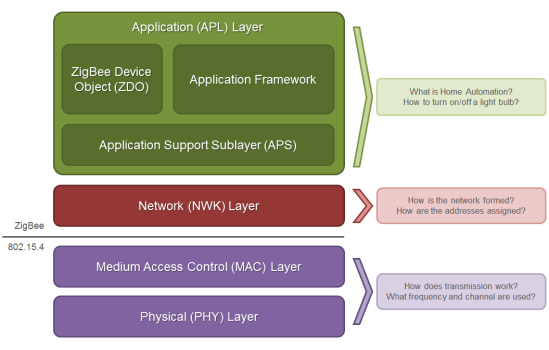Zigbee stack layers
Most network protocols use the concept of layers to separate different components and functions into independent modules that can be assembled in different ways.
Zigbee is built on the Physical (PHY) layer and Medium Access Control (MAC) sub-layer defined in the IEEE 802.15.4 standard. These layers handle low-level network operations such as addressing and message transmission/reception.
The Zigbee specification defines the Network (NWK) layer and the framework for the application (APL) layer. The Network layer takes care of the network structure, routing, and security. The application layer framework consists of the Application Support sub-layer (APS), the Zigbee device objects (ZDO) and user-defined applications that give the device its specific functionality.

This table describes the Zigbee layers.
| Zigbee layer | Descriptions |
|---|---|
| PHY | Defines the physical operation of the Zigbee device including receive sensitivity, channel rejection, output power, number of channels, chip modulation, and transmission rate specifications. Most Zigbee applications operate on the 2.4 GHz ISM band at a 250 kb/s data rate. See the IEEE 802.15.4 specification for details. |
| MAC | Manages RF data transactions between neighboring devices (point to point). The MAC includes services such as transmission retry and acknowledgment management, and collision avoidance techniques (CSMA-CA). |
| Network | Adds routing capabilities that allows RF data packets to traverse multiple devices (multiple hops) to route data from source to destination (peer to peer). |
| APS (AF) | Application layer that defines various addressing objects including profiles, clusters, and endpoints. |
| ZDO | Application layer that provides device and service discovery features and advanced network management capabilities. |
 PDF
PDF


